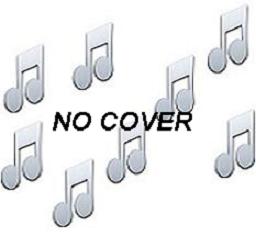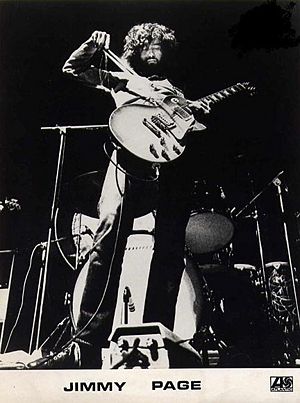Dazed and Confused (Led Zeppelin song): Difference between revisions
imported>Meg Taylor (infobox) |
imported>Meg Taylor m (image) |
||
| Line 2: | Line 2: | ||
{{Infobox Song | {{Infobox Song | ||
|name = Dazed and Confused | |name = Dazed and Confused | ||
|image = Nocover.jpg | |image = [[Image:Nocover.jpg]] | ||
|album = ''Led Zeppelin'' | |album = ''Led Zeppelin'' | ||
|published = Superhype Music | |published = Superhype Music | ||
Revision as of 04:01, 20 June 2008
| Dazed and Confused | |
|---|---|

| |
| Appears on | Led Zeppelin |
| Published by | Superhype Music |
| Release date | February 1969 |
| Recorded | October 1968 |
| Genre | Psychedelic rock |
| Language | English |
| Length | 6 min 26 sec |
| Composer | Jimmy Page |
| Label | Atlantic Records |
| Producer | Jimmy Page |
Dazed and Confused is a song rewritten and arranged by British rock group Led Zeppelin, based on an original composition by Jake Holmes, also titled "Dazed and Confused". Led Zeppelin's heavier and electric Dazed and Confused was considered so significantly different from the Holmes acoustic version that the American Society of Composers, Authors and Publishers (ASCAP) assigned the unique serial registration of 340128276[1] to its copyright, lodged by the newly created music publisher Superhype Music in 1968. Led Zeppelin's Dazed and Confused has since been widely covered and was an early performance highlight for the group.
Album version
Engineered and mixed by Glyn Johns at Olympic Studios, London in October 1968, "Dazed and Confused" was included as a key track on Led Zeppelin's eponymous 1969 début album, Led Zeppelin. The final album version was just the second of two takes the group recorded, with only the violin bow section overdubbed.[2] Opening with a measured slow-tempo rhythm accentuated by John Paul Jones' descending bass line in the key of G Major, it builds to a climactic menacing performance, initiated by John Bonham's intense drumming and Jimmy Page's rapid fire guitar solo.[3] Jones' bass playing lays down the song structure, with a tenth jump from E then to G, followed by a descending G-F#-F-E pattern switching to D-C#-C-B. Page's single note playing is two octaves above, doubling the chromatic ostinato of the bass. This riff pattern is used throughout as an instrumental link and during the verse, only to be broken by a second riff on B, consisting of B-E-F#-A-B in one bar.
A song very much influenced by the psychedelic period, with Robert Plant's manic blues-inflected pleading and Page's use of bowed guitar imbuing a sense of emotional foreboding.[4] Page's main instrument for the recording was a 1958 Fender Telecaster with Supro amplification, a Vox wah pedal modified by Roger Mayer, and the ambience on the solo was achieved using EMT plate reverb.[5] His frenetic solo adapted from an earlier recording he appeared on called "Think About It", which was a b-side on The Yardbirds final studio output. Page would later use his bowing technique on a number of other tracks, most notably "How Many More Times", "LA Drone" and "In the Light".[6] Unreleased recordings of Kenneth Anger's Lucifer Rising soundtrack also contained extensive use of his bowing technique.
| “ | I just wanted the guitar to sound different.[7] | ” |
Live performances

Jimmy Page performing his bowed guitar solo in "Dazed and Confused", at Ulster Hall, Belfast on March 5, 1971.
Concert performances of "Dazed and Confused" gradually extended the improvised solos up to 45 minutes in duration, by 1975. The bowed and guitar solo sections in total would encompass up to 15 minutes alone. Progressively the bowed guitar solo was given room for extended free-form improvisation, which included a krypton laser light show in the latter half of the 1970s, to add to the theatrical spectacle.[8] Further instrumental flourishes were added between the verses after 1972, punctuating the lyrical mannerisms of Plant. "Dazed and Confused" was briefly dropped at the start of 1975 after Page suffered a dislocation of his ring finger on his left hand, and the song was temporarily replaced with the easier "How Many More Times" in the setlist. The song has been performed on every tour, until after 1975's series of Earl Court shows, at which time it was rested for a revamped setlist for the 1977 American tour, with only snippets played within a song medley of "Achilles Last Stand".[9] Page again presented it on his solo appearances and it was performed once again with Led Zeppelin at the O2 Arena, London for the Ahmet Ertegün Tribute Concert, on December 10, 2007.
"Dazed and Confused" has appeared on countless bootleg recordings, including the (in)famous Live on Blueberry Hill release. The only official live releases has been the 1976 in-concert film The Song Remains the Same featuring a version from 1973, synched with Page's fantasy sequence of a hooded hermit changing into Page as Father Time, being acted out on the face of a snow capped Scottish mountain. The double disc compilation DVD, Led Zeppelin and the BBC Sessions album also contain various live permutations of "Dazed and Confused".
Song incorporation
The improvisational nature of the live version of "Dazed and Confused" allowed for other Led Zeppelin material and favourite covers to be eased into the composition. "The Crunge" and "Walter's Walk" were added by 1972, and these can be heard on the triple live album How the West was Won. Elements of "Ozone Baby" was added during their US tour of 1975.[10] During the Japan tour of 1972, anything was fair game and within the next 12 months, Plant would also sing lyrics from either Scott McKenzie's "San Francisco (Be Sure to Wear Flowers in Your Hair)", Joni Mitchell's "Woodstock" or even rarer The Eagles "Take It Easy" during the song's evolution.[11] Gustav Holst's "Mars, the Bringer of War" from "The Planets" suite would also be incorporated into part of the bowed guitar solo.
Cultural influences
Film director Richard Linklater used the title of the song for the basis of his 1993 theatrical period piece release Dazed and Confused, based on the lives of high school students in the summer of 1976. The film soundtrack however did not utilise the song, despite pleas from Linklater to members of the band. Page agreed after some hesitation but Plant declined. The director had planned to use it for the opening credits of the film, which eventually went to Aerosmith's "Sweet Emotions". Linklater retained the title as the script described his, and his friends', high school experiences in the 1970s.[12]
In the long running animated sitcom series The Simpsons, the episode entitled "The Front" (Season 4, Episode 19) featured an Itchy & Scratchy sketch called "Dazed and Contused", a pun on the song title. "Dazed and Contused"'s storyline revolved around Itchy & Scratchy telling kids to say no to drugs after their standard splatterfest.
Notes
- ↑ ASCAP website
- ↑ Benson, Joe (1995). Uncle Joe's Record Guide: Hard Rock: Volume 1, Revised Edition. London: J Benson Unlimited, p. 12. ISBN 0-943031-14-1.
- ↑ Welch, Chris (2001). The Stories Behind Every Song: Led Zeppelin: Dazed and Confused, Revised Edition. New York: Thunder's Mouth Press Press, p. 23. ISBN 1-56025-188-3.
- ↑ Williamson, Nigel (2007). The Rough Guide to Led Zeppelin, 1st Edition. London: Rough Guides, p. 218. ISBN 1-84353-841-7.
- ↑ Jimmy Page interview in "Hammer of the Gods", Guitar World (October 1993) Vol. 14 No. 2.
- ↑ Fast, Susan (2001). In the Houses of the Holy: Led Zeppelin and the Power of Rock Music, 1st Edition. New York: Oxford University Press, p. 30. ISBN 0-19-511756-5.
- ↑ Jimmy Page, 1969
- ↑ Steve Waksman, "Rock Guitar from the 1950s to the 1970s" in Coelho, Victor (ed.) The Cambridge Companion to the Guitar, 1st Edition, Cambridge: Cambridge University Press, 2003, p. 119, ISBN 0-521-80192-3
- ↑ Dave Lewis (1994), The Complete Guide to the Music of Led Zeppelin, Omnibus Press, ISBN 0-7119-3528-9.
- ↑ Lewis, Dave (2004). Led Zeppelin: The Complete Guide to Their Music, 1st Edition. London: Omnibus Press, p. 66. ISBN 1-84449-141-2.
- ↑ Lewis, Dave (2001). Led Zeppelin: A Celebration, Revised Edition. London: Omnibus Press, p. 54. ISBN 0-7119-9651-2.
- ↑ Linklater, Richard and Montogomery, Denise (eds.) (1993). Dazed and Confused: Inspired by the Screenplay by Richard Linklater, 1st Edition. New York: St. Martin's Press. ISBN 0-312-09466-3.